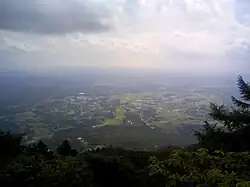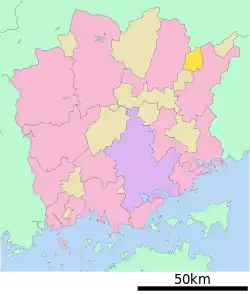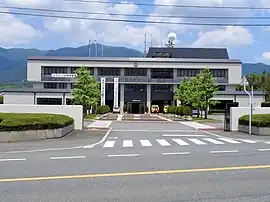Nagi
奈義町 | |
|---|---|
 View of Nagi | |
 Flag  Chapter | |
Location of Nagi in Okayama Prefecture | |
 | |
 Nagi Location in Japan | |
| Coordinates: 35°7′N 134°11′E / 35.117°N 134.183°E | |
| Country | Japan |
| Region | Chūgoku San'yō |
| Prefecture | Okayama |
| District | Katsuta |
| Area | |
| • Total | 69.52 km2 (26.84 sq mi) |
| Population (September 1, 2022) | |
| • Total | 5,738 |
| • Density | 83/km2 (210/sq mi) |
| Time zone | UTC+09:00 (JST) |
| City hall address | 306-1 Toyosawa, Nagi-cho, Katsuta-gun, Okayama-ken 708-1392 |
| Climate | Cfa |
| Website | Official website |
| Symbols | |
| Flower | Prunus mume |
| Tree | Ginkgo biloba |

Nagi (奈義町, Nagi-chō) is a town located in Katsuta District, Okayama Prefecture, Japan. As of 1 September 2022, the town had an estimated population of 5,738 in 1512 households and a population density of 83 persons per km².[1] The total area of the town is 69.52 square kilometres (26.84 sq mi).
Geography
Nagi is located in the northeastern part of Okayama Prefecture, bordered by Tottori Prefecture to the north. Located on the southern side of the Chugoku Mountains, mountains and forests occupy the northern town area; and the town is designated as a heavy snowfall area. Mount Nagi (1255 meters) from which the town derives its name, is located on the border between Nagi and Chizu, Tottori. The southern part of the city is a plateau called the Nihonbara Plateau, where the Ground Self-Defense Force Camp Nihonbara and the Nihonbara Maneuver Area are located.
Neighboring municipalities
Okayama Prefecture
Tottori Prefecture
Climate
Nagi has a humid subtropical climate (Köppen climate classification Cfa). The average annual temperature in Nagi is 13.4 °C (56.1 °F). The average annual rainfall is 1,511.0 mm (59.49 in) with July as the wettest month. The temperatures are highest on average in August, at around 25.7 °C (78.3 °F), and lowest in January, at around 1.8 °C (35.2 °F).[2] The highest temperature ever recorded in Nagi was 37.2 °C (99.0 °F) on 6 August 1994; the coldest temperature ever recorded was −15.5 °C (4.1 °F) on 3 February 2012.[3]
| Climate data for Nagi (1991−2020 normals, extremes 1977−present) | |||||||||||||
|---|---|---|---|---|---|---|---|---|---|---|---|---|---|
| Month | Jan | Feb | Mar | Apr | May | Jun | Jul | Aug | Sep | Oct | Nov | Dec | Year |
| Record high °C (°F) | 14.4 (57.9) |
20.1 (68.2) |
24.3 (75.7) |
28.9 (84.0) |
31.9 (89.4) |
35.2 (95.4) |
36.8 (98.2) |
37.2 (99.0) |
35.1 (95.2) |
29.5 (85.1) |
24.8 (76.6) |
18.6 (65.5) |
37.2 (99.0) |
| Mean daily maximum °C (°F) | 6.8 (44.2) |
7.9 (46.2) |
12.1 (53.8) |
18.3 (64.9) |
23.2 (73.8) |
26.2 (79.2) |
29.7 (85.5) |
31.2 (88.2) |
27.0 (80.6) |
21.3 (70.3) |
15.2 (59.4) |
9.2 (48.6) |
19.0 (66.2) |
| Daily mean °C (°F) | 1.8 (35.2) |
2.6 (36.7) |
6.1 (43.0) |
11.6 (52.9) |
17.0 (62.6) |
21.0 (69.8) |
24.8 (76.6) |
25.7 (78.3) |
21.6 (70.9) |
15.3 (59.5) |
9.1 (48.4) |
3.8 (38.8) |
13.4 (56.1) |
| Mean daily minimum °C (°F) | −2.7 (27.1) |
−2.4 (27.7) |
0.3 (32.5) |
4.8 (40.6) |
11.0 (51.8) |
16.6 (61.9) |
21.1 (70.0) |
21.5 (70.7) |
17.0 (62.6) |
9.9 (49.8) |
3.7 (38.7) |
−0.9 (30.4) |
8.3 (47.0) |
| Record low °C (°F) | −13.7 (7.3) |
−15.5 (4.1) |
−11.5 (11.3) |
−4.4 (24.1) |
0.8 (33.4) |
6.8 (44.2) |
11.8 (53.2) |
12.8 (55.0) |
5.8 (42.4) |
0.0 (32.0) |
−5.3 (22.5) |
−11.0 (12.2) |
−15.5 (4.1) |
| Average precipitation mm (inches) | 60.3 (2.37) |
67.5 (2.66) |
105.1 (4.14) |
120.1 (4.73) |
157.3 (6.19) |
191.3 (7.53) |
253.4 (9.98) |
147.5 (5.81) |
172.6 (6.80) |
103.8 (4.09) |
67.8 (2.67) |
64.5 (2.54) |
1,511 (59.49) |
| Average precipitation days (≥ 1.0 mm) | 9.6 | 10.2 | 10.9 | 10.2 | 10.7 | 12.0 | 12.8 | 9.7 | 10.5 | 8.0 | 7.7 | 9.2 | 121.5 |
| Mean monthly sunshine hours | 109.3 | 117.1 | 161.4 | 185.4 | 190.7 | 136.9 | 137.4 | 173.3 | 140.9 | 150.1 | 126.7 | 109.1 | 1,738.3 |
| Source: Japan Meteorological Agency[2][3] | |||||||||||||
Demographics
Per Japanese census data, the population of Nagi in 2020 is 5,578 people.[4] Nagi has been conducting censuses since 1920.
| Year | Pop. | ±% |
|---|---|---|
| 1920 | 6,892 | — |
| 1925 | 6,794 | −1.4% |
| 1930 | 6,743 | −0.8% |
| 1935 | 6,626 | −1.7% |
| 1940 | 6,636 | +0.2% |
| 1945 | 8,761 | +32.0% |
| 1950 | 9,136 | +4.3% |
| 1955 | 8,925 | −2.3% |
| 1960 | 8,188 | −8.3% |
| 1965 | 7,401 | −9.6% |
| 1970 | 7,010 | −5.3% |
| 1975 | 7,716 | +10.1% |
| 1980 | 7,818 | +1.3% |
| 1985 | 7,905 | +1.1% |
| 1990 | 7,577 | −4.1% |
| 1995 | 7,230 | −4.6% |
| 2000 | 6,690 | −7.5% |
| 2005 | 6,475 | −3.2% |
| 2010 | 6,086 | −6.0% |
| 2015 | 5,906 | −3.0% |
| 2020 | 5,578 | −5.6% |
| Nagi population statistics[4] | ||
Child subsidies
As of August 2005, the fertility rate was 1.4 children per woman. Measures were implemented to encourage having more children, including providing free medical care to children aged 18 or under, helping students going to high schools outside the town with their commuting expenses, and providing day care for sick children,[5] as well as providing cheap rental properties and paying birth gifts of up to ¥400,000.[6]
The birthrate briefly increased to 2.8 in 2014, but according to an article in The Economist, one estimate gave the birthrate as 1.9 by 2018, which was still higher than the national average.[7] As such, the town’s higher birth rate, coupled with the financial incentives on offer has led to Nagi being referred to as a ‘miracle town’.[8]
History
Nagi is part of ancient Mimasaka Province. After the Meiji restoration, the villages of Kitayoshino, Toyota and Toyonami were established with the creation of the modern municipalities system on June 1,1889. These three villages merged on February 1, 1955 to form the town of Nagi.
Government
Nagi has a mayor-council form of government with a directly elected mayor and a unicameral town council of ten members. Nagi, collectively with the city of Tsuyama and the towns of Kagami and Shōō, contributes four members to the Okayama Prefectural Assembly. In terms of national politics, the town is part of the Okayama 3rd district of the lower house of the Diet of Japan.
Economy
The main industry in the area is forestry and agriculture. Wasabi is a noted local product. The Higashiyama Industrial Park is located in the southeastern part of the city.
Education
Nagi has one public elementary school and one public junior high school operated by the town government. The town does not have a high school.
Transportation
Railway
The JR West Kishin Line runs on the south side of the town, and the Inbi Line runs on the west and north sides of the town; however, Nagi does not have any passenger railway service. The nearest train station is Tsuyama Station, which can be reached by bus.
Highways
Nagi is not located on any national expressway or highway. The nearest interchange is the Chugoku Expressway Tsuyama IC/Mimasaka IC.
Local attractions
Notable people from Nagi
- Masashi Kishimoto, creator of the anime/manga series Naruto. The town of Nagi was the inspiration for the village of Konoha, where most of the protagonists of Naruto live.
References
- ↑ "Nagi town official statistics" (in Japanese). Japan.
- 1 2 気象庁 / 平年値(年・月ごとの値). JMA. Retrieved May 10, 2022.
- 1 2 観測史上1~10位の値(年間を通じての値). JMA. Retrieved May 10, 2022.
- 1 2 Nagi population statistics
- ↑ "JCP efforts help to boost birthrate in country town". Japan Press Weekly. 1 December 2015.
- ↑ "Despite government reluctance, Japan's population outlook makes immigration talk inevitable". Japan Times. 11 April 2017.
- ↑ "A small town in Japan doubles its fertility rate". The Economist. 2018-01-09.
- ↑ "Baby boomtown: does Nagi hold the secret to repopulating Japan? | Japan | The Guardian". amp.theguardian.com. Retrieved 2023-12-11.
External links
 Media related to Nagi, Okayama at Wikimedia Commons
Media related to Nagi, Okayama at Wikimedia Commons- Nagi official website (in Japanese)